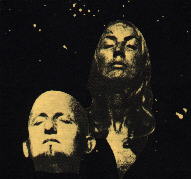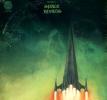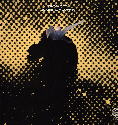Glass Top Coffin - Review
"The dreamer dreamed the dust rose up andwalked
But when the dreamer woke did anyone tell the dust
-and I fell-
and stars like dust covered me"
The failure of Space Hymns and the elapse of three years before the release of Glass Top Coffin seem to have taken their toll on Ramases' musicianship. Gone are the obvious religious overtones within the music as well as the tantric chants that characterized the debut album. Instead the music presented is totally unreflective and has practically no musical link at all with Space Hymns.
In fact one feels that over this period, which was an especially long period in musical terms during the seventies when groups would churn out even two albums a year, that Ramases has matured musically. The overall layout of this album involves a rich orchestral sound coupled with straight forward ear-friendly tracks, almost sounding like a musical at times, yet on the whole a pleasant album to listen to.
Golden Landing opens the album and the title, at least, shows that Ramases still had a penchant for aliens and religion. The initial sound involves some high-pitched violins, almost like a scenario out of a horror film. Interestingly, vocals seem to be by Sel and one is immediately impressed by the musical changes between this album and its predecessor. The setting could easily have been for a 50's song sung by Judy Garland or Frances Faye! Ramases' voice enters midway through the song, smooth and crystal clear, yet not even his entry encourages a hint of rock music.
Long Long Time sees the inclusion of rock instruments, yet one can sense the influence of groups such as The Moody Blues when you hear the inclusion and incorporation into the framework of an orchestra. Somehow throughout the track there is an underlying sense of melancholy, a feeling of disappointment from Ramases, and this feeling seems to be deep set and prevails throughout the album. Musically the orchestra maintains that edge over the rock instrumentation, though that musical maturity shows up once again as the instrumental sections of this track demonstrate together with the filling licks.
Ramases returns as the main vocalist on Now Mona Lisa in which he analyzes the thoughts of the Mona Lisa as she stares out from her portrait at the world going by. Eventually, Sel enters the fray taking on the part of Mona Lisa creating a nice vocal duet, though musically there is little difference from the previous track with a mixture of orchestra and group.
The first link to Space Hymns appears relatively late on in the album. On God Voice, Ramases (whose voice sounds so much like early Chris de Burgh!) there is a touch of that mantra style that was splashed all over the first album. This time the chants are just relegated to the chorus while Ramases speaks out about being a god (or a chosen one) and how he should be revered by all. Backing vocals are used to good effect here, as on most of the album. An interesting point is that two of the backing vocalists (Sue Glover and Sunny Leslie) were from Brotherhood Of Man.
God Voice merges into Mind Island which is also the first track that does not feature the orchestra. Here one can hear Bon Bertles (Nucleus) with one of his characteristic solos to the sound of a gong that creates that spacey effect together with an acoustic backing. This is a pleasant enough and unobtrusive track that blends in well with the laid back and melancholic nature of the album. Side 1 comes to an end with Only The Loneliest Feeling which retains that effect that sounds like breaking surf while the voice is accompanied by a cello and double bass.
Side 2 starts off with Sweet Reason, which has a touch of Marianne Faithfull in it (at least as far as the voice goes!). The track utilizes all the musical derivatives to be expected of a seventies track with soaring vocal harmonies responded by a horn section while the backing rhythm is almost cabaret-like in style, yet somehow still being able to maintain that religious almost church-like touch. Hearing it reminds me of the track My Sweet Lord from All Things Must Pass (George Harrisson).
Stepping Stones acts as a filler being devoid of any musical value and extremely repetitive, though not to the extent of the tracks on Space Hymns. Notwithstanding that, it serves as a relaxing piece of music with the gentle whispers towards the end of the track acting as a beckoning to those who could have been hypnotized by it. It also serves as an introduction to what could be assumed to be the most commercial track on the album, Saler Man. Possibly this track could have been short listed as a possible single with the Chris de Burgh comparison re-emerging as Ramases sings accompanied by an orchestra with the occasional touch of an acoustic guitar.
Retaining that orchestral based structure, Children Of The Green Earth acts as a beckoning to all followers/faithful to be collected from the star field for a promise of a better life. The title track Glass Top Coffin sounds so much out of place as instead of the laid back orchestral sounds we have a wailing guitar and a rock beat, though the orchestra is still present but relegated to the background. All in all it remains an interesting piece of music and shows that despite everything, Ramases still had place for rock music! Of interest in this track is the vocal harmony break mid-way through the track followed by a short hint of delving into what could have been a nice instrumental section (in true progressive style!) yet this is short-lived as Ramases re-enters the fray with his vocals. The closing number Golden Landing II is a reprise of the opening track sounding very much like the closing number of a soundtrack!
Musically, Glass Top Coffin is by far superior to Space Hymns, however, this album like its predecessor has sunk without a trace. In actual fact it makes a very relaxing listen as the orchestration as well as the vocal parts is superb. Monotony and repetitiveness is almost non-existent on this album (unlike Space Hymns) while the religious undertones, when present, are almost negligible.
Unfortunately history would dictate that this album would flounder to the extent that it has not even been made available on CD as yet, which is a pity. From a progressive rock point of view, this would be of no great loss as Space Hymns should be the one to appeal to the progressive rock fan. Having said that Glass Top Coffin does have its moment and the combination of rock and orchestra is brought out to full effect here and it is of particular interest to see how a musician could have progressed from two widely different bodies of music in such a short time span.
This review originally appeared on the Dutch Progressive Rock website and is reprinted here by the kind permission of Nigel Camilleri.
INTRODUCTION |BIOGRAPHY |DISCOGRAPHY |FORUM |LINKS


